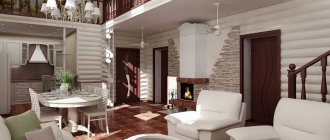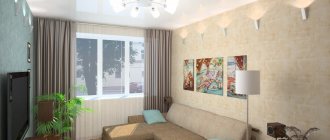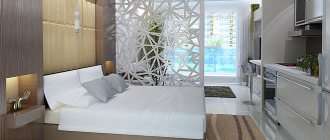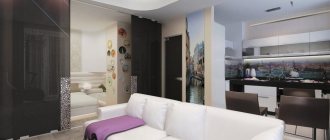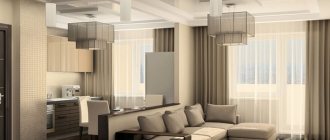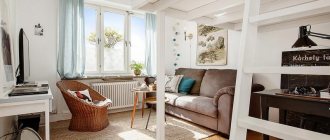The idea of creating studio apartments first came to mind to American architects. Premises with a similar layout quickly became fashionable. The word “studio” came to us from the Italian language, where it meant a spacious workshop of artists or sculptors. Such apartments are characterized by a relatively low cost, which makes it easier for those who previously could only dream of buying a home. For example, in the West, such options are considered budget options, which are in demand among young families. Studio projects are also being implemented within two- and one-room apartments. They allow you to fit several rooms in one room without compromising the visual perception of space. The design of a living room-studio has a number of nuances that will have to be taken into account when creating the project. Such premises can boast of advantages, but are not without disadvantages. Arranging a studio in a private house is more of a whim, while decorating combined options in Khrushchev-era buildings is an urgent need.
Advantages and disadvantages
The studio living room is a universal space. The hall will tolerate any “neighborhood”. It is combined with kitchens, bedrooms, dining rooms, children's rooms, workshops and work rooms. With the help of a number of design tricks, any additional room can be organically fit into the framework of both a spacious and cramped room. For owners of two-room apartments, the task is simplified, since they can organize large-scale redevelopment and combine two spaces into one. The studio lives by its own laws and does not allow chaos into its territory. This room is strictly divided into zones, the placement of which is guided by rational considerations. The combination has the following advantages:
- Space saving. In some cases, this is even the only opportunity to equip an additional area. When remodeling an apartment, you can make one, but spacious one from two small rooms. For example, a small kitchenette seemed so tiny that even looking at it felt “cramped.” Any tricks of designers do not save the situation. Demolishing a wall and installing a decorative partition with niches or a bar counter will help radically change the perception of this room. Now, subconsciously, it will be seen as a continuation of the spacious guest room.
- An opportunity to be original for owners of country houses and country houses. This way you can show that the word “fashion” is not an empty phrase for them.
- Space for imagination. Where each zone will be located and how many square meters the owners are willing to allocate for it, only they themselves decide.
- In kitchen-living rooms, you won’t have to go far to find treats for guests who will be sitting in a group in the hall. If the space is divided by a bar counter, then here you can serve cocktails and chat with friends without interrupting the process of preparing culinary masterpieces.
- In kitchen-living rooms, which are also combined with dining rooms, the process of setting the table for a meal will be simplified. No more walking through a maze of walk-through rooms to get plates of food to the dining area.
- A wide range of transformable furniture will allow you to furnish the room with taste without sacrificing functionality. The furnishings will be compact and neat, without clutter that visually reduces the space.
Disadvantages include:
- Lack of sound insulation. Unfortunately, mobile or static decorative partitions and conventional space dividers completely exclude the presence of any isolation of premises other than visual.
- In kitchen-living room options, frequent changes of textiles are inevitable, which will be saturated with the smells of the culinary half of the room.
- Lack of natural light. If initially there was only one room, and did not become the result of redevelopment, then only the area adjacent to the window will bathe in the rays of the sun. The septum will worsen the situation. The far area, located closer to the door, will have to be illuminated artificially.
It is not recommended to combine rooms with contrasting functional purposes using conventional boundaries. For example, the bedroom and living room are opposite rooms in atmosphere and purpose of use. In the first they rest quietly, and in the second with noise. Accordingly, you cannot delimit zones with light or a podium, since you will not be able to fall asleep in the presence of a group of guests.
Selection of furniture
Living room furniture must meet the following criteria:
- single style;
- a small number of items;
- spaciousness and functionality;
- monochrome.
It is better to avoid chests of drawers and bedside tables to save space. In the hall it is best to place one closet and an open shelving for accessories and books. The general style of furniture and interior will make the space unified and harmonious. If you plan to install multi-colored furniture, it will look great against the background of plain walls and ceiling.
In the photo you can also see design options for living room studios, created in different styles. However, this must be implemented carefully and preferably with the help of professionals. Otherwise, the room may turn out pretentious and tasteless.
Kitchen-living room
The interior design of the kitchen-living room involves a number of nuances. To begin with, the aggressive microclimate of the culinary area must not be allowed to penetrate into the recreation area. The hood and ventilation system must cope with the assigned tasks so that the living room does not suffer from constant temperature changes and high humidity. It is recommended, of course, to establish the actual separation of zones. It will, at least a little, protect the room from the kitchen and by-products of cooking (odor and fat). Professionals also advise using a minimum of textiles. In any case, you will have to wash it often. For upholstered furniture, it is better to provide special protective covers. You cannot use synthetics in the design, which will quickly become unusable from frequent washing. It is necessary to combine spaces wisely. The hall in this situation acts as the “leading” room. The kitchen is often given a small corner. A relevant option is to separate two spaces with a bar counter or a countertop with a stove. You might have seen the last solution in cooking programs. In large rooms (dachas or country houses), where there is space for “maneuvering,” an island type of kitchen unit placement is organized. This type of layout is considered stylish and fashionable.
We hide everything!
For a wardrobe, a built-in wardrobe is best. Size from floor to ceiling. With many shelves, drawers, cabinets and rails
. Then you can lay out various utensils in ceiling drawers, and place boxes of shoes on the floor under a coat hanging on hangers.
Designers working on studios advise “hiding” the washing machine under the countertop in the kitchen or in the bathroom.
Combined with a bathroom, this room usually requires a minimum of items - for example, a cabinet in a bright color that contrasts with the walls, for detergents and hygiene items.
Kitchen-living-dining room
Three zones in one bottle is a risky option. The dining room is usually considered as an addition to either the kitchen or the living room. She is not considered one of the “leaders” of the troika, so the space for eating is minimal. It can be a “buffer”, a transition zone between the kitchen and the living room, or sit comfortably in a corner where it won’t interfere. The first option is preferable, since in this case the intermediate zone will protect the living room from the kitchen microclimate. If the room has a bay window, then the dining room is arranged near the window. During lunch, household members will be able to admire the beautiful views and bathe in the sun. Also keep in mind that when dividing zones by color, the eating area is decorated in warm colors. They have a beneficial effect on appetite and create a comfortable atmosphere.
Space planning
Before you start designing and decorating, set all your priorities:
— An important question: was the studio originally like this, or is it an ordinary modified one-room apartment. This affects the area of the space, its configuration, and the location of windows.
— Design the room taking into account its shape. In ordinary rectangular and square studios, classic interiors look interesting. And in new non-standard layouts with rounded shapes and beveled corners, modern trends play more interestingly.
— Be sure to consider how many people will live in the apartment, because the needs of an individual, a couple or a family with a child are very different. If you have a baby, first of all focus on the safety and practicality of the design.
— Depending on your lifestyle, your needs change. Some people need a living area, others need an office, a workshop or a small dressing room in the corner. All this directly affects the design of the apartment.
Stylistic directions
There are a lot of stylistic options in design. To decorate a living room-studio, it is recommended to adhere to the framework of one direction or several adjacent ones. A strong stylistic contrast can “hurt” the perception of the room. Instead of one studio, you will see several zones creating a chaotic pile-up. Let's look at some of the areas in demand by designers and studio owners.
Classic, despite the fact that it is classified as an old style, remains relevant to this day. The direction changed slightly, became more elegant, introduced modern household appliances into the interiors, which one can no longer do without, but remained true to itself and its rules. In the classical style, decorative columns are used to separate zones. They blend organically into the decor and harmonize with the stucco on the ceiling. The walls are plastered or covered with wallpaper with floral patterns. The floor is finished with parquet boards or laminate. The upholstery of upholstered furniture is replete with small floral patterns. The windows are covered with heavy curtains made of natural fabric, which during the day are tied with neat ropes with tassels at the ends. A decorative fireplace decorated with artificial stone or stucco is installed in the living room area. Ottomans, coffee tables, chests of drawers and cabinets stand on graceful, twisted legs. The walls are decorated with reproductions of paintings by famous artists in baguette frames with gilding. A heavy crystal chandelier hangs from the ceiling. The color scheme is dominated by shades of brown: gold, sand, beige, cream. For contrast, add a couple of blue, terracotta, wine “spots”.
Loft is considered a product of urbanization. It combines details that were previously unimaginable. Rough brick walls alternate with smooth, snow-white plaster. The ceiling is decorated with wooden beams. There are no curtains on the windows at all; they are replaced by practical blinds. The studio living room is literally bathed in artificial lighting, which is organized on three levels. Modern household appliances and furniture blend organically into the composition. Communications are exposed for everyone to see. They become a decorative element. Loft belongs to the group of elite styles that are suitable for decorating country mansions.
The Provence style living room has a special atmosphere of cozy, romantic antiquity. The color scheme is dominated by white, beige, pink and blue. Soft and calm shades are enlivened by the abundance of floral patterns on wallpaper and textiles. The floor is finished with parquet boards, which are additionally painted white. Apply only one layer so that rough strokes are visible on the surface. The furniture uses antiques or exclusive parts, artificially aged. Particular attention is paid to the decor: small pillows, bedspreads, figurines, vases with flowers and pots with living plants. A heavy chandelier with light bulbs imitating candles is hung on the ceiling. It is additionally decorated with artificial pearls. The floor is covered with a soft carpet with a classic geometric pattern. The walls are decorated with picturesque paintings in round frames.
American Art Deco is like a medley of classical and modern styles. Finishing materials use wood and plastic. The upholstery of sofas and armchairs is made of genuine leather in solid colors. The prevailing shades are olive, beige, gray, and white. Accents are made in blue, green, purple and light blue tones. The floor is covered with laminate. A stretch ceiling with a glossy surface of a light shade will allow you to extend the room in height. Against the background of plain walls, an accent zone with floral patterns will look stylish and organic.
You can combine minimalism and high-tech, Provence and romantic style, classic and modern, fusion and eclecticism, futurism and post-punk, constructivism and cubism.
Interior details in the studio
Like any other interior, the studio should not be devoid of decorative elements. The choice of paintings or posters, textiles, accessories must be in accordance with the chosen style, support and complement it.
Thanks to textiles, you can add bright accents to the created monochromatic interior. Then, when you change the curtains or pillows on the sofa, you can use affordable means to update the interior and add new details to it. The experience of changing decor can be made seasonal by adjusting each new interior to the seasons. This experience is especially relevant for studios, whose residents actually exist in a single interior 24 hours a day.
The decor can also support the zoning of space, for example, there can be different color schemes in different functional areas of the studio. It is important here not to overload the interior with an abundance of decorative detail, but to choose two or three main directions and stick to them.
Zoning methods
Studio zoning options are divided into non-conventional and actual. The former allow you to visually separate one site from another, while the latter do not hint, but say it directly. Zoning can be carried out using the following techniques:
- Furniture. The option refers to the actual one, since a material object is placed on the border, which is an obstacle.
- Color composition or using combined finishing materials. This method is considered conditional.
- Different levels on the ceiling or a podium on the floor.
- With the help of lighting.
- Arches or decorative walls.
- Sliding-type structures or mobile partitions.
The methods can be combined with each other if the interior composition allows it.
Furniture arrangement
Furniture zoning is usually carried out using sofas, cabinets or open shelving. A long, narrow table can also act as a separator. When arranging furniture, it is worth considering that you are unconsciously creating “routes” for moving around the room. They should be comfortable with a minimum of obstructions. Otherwise, movements will be associated with unnecessary body movements and internal discomfort. The sofa across the living room evokes conflicting impressions. Some people may feel discomfort without having a closed “rear.” The rack is still considered the best option. It both decorates the living room and creates an actual border that is easily perceived subconsciously.
Wall color and finishing materials
Zoning based on contrasts plays on people's psychology. Color perception will automatically immediately separate one zone from another. The effect will be enhanced by combined finishing. The combination of different textures will even make the zones more “independent”. For example, the combination of relief plaster with regular, smooth plaster looks organic. Light paint with delicate wallpaper also looks good. The loft combines brick or masonry with plaster. Color contrasts can be bright, which is only acceptable in spacious rooms, or smooth, with a soft transition.
Pros and cons of the podium
In kitchen-living rooms, it is recommended to install a cooking area on a raised surface. It is not as spacious as the hall, and such a reception will slightly highlight and elevate it in the eyes of the household. If they combine a living room with a bedroom, then a bed is placed on the podium. The step causes aversion for many people, because at first, out of habit, they constantly trip over it. However, if the podium has a complex design, then it can be used as additional storage space. Drawers are built into it, which are cleverly disguised. The podium is considered a modern design solution. It will look more organic with a decorative “step” on the ceiling of a similar shape.
Bar counter or island
A bar counter is considered a universal option that will add work space in the kitchen and actually divide spaces. In addition, such furniture is relevant for those owners who like to gather noisy companies. No one will refuse a couple of invigorating cocktails. On the living room side, the counter is complemented by high chairs, in the best traditions of bar establishments. A special shelf with holders for bottles and glasses is installed on top. “Island” is a type of kitchen unit arrangement. It is a separate tabletop, most often together with a stove, so as not to go beyond the working “triangle”. Island layouts are used only in large rooms. A small piece of “land” detached from the mainland will serve as the actual border at the junction of two zones and will allow you to decorate the interior in an original way.
Sliding structures
Sliding structures are represented by screens, doors and accordion partitions. Sometimes they are also called “wandering” or “drifting” walls. Screens are classified as mobile partitions. They can be removed from the room completely at any time. Sliding doors and accordion partitions “move apart” to the sides. They can be made of various materials: plasterboard, MDF, plastic, glass, fabric in metal frames. An interesting option is rotating partitions. Of course, they will have to organize space for “maneuver”, so interior objects are only allowed in spacious rooms. Original options are decorated with living plants, which can also be periodically moved from the shade to the sun's rays. Regulating the light level will allow you to control the growth of home flora.
Multi-level ceiling and lighting
Different ceiling levels are traditionally emphasized by lighting fixtures. Spotlights not only add decorative, diffused light to the room, but also emphasize the surface relief. Additionally, light bulbs are installed around the perimeter of the room and in the area of accent zones. This solution looks stylish and elegant. Multi-level ceilings with additional lighting organically blend into loft, high-tech and minimalism. If the room is small, then it is visually enlarged due to reflective surfaces that play in cold decorative light.
Decorative touches of the combined room
The decor of a combined room plays an important role in separating zones. Using decorations of different styles, you can further delimit spaces. A lot of textiles are used in the living room: curtains, upholstery, rugs, pillows, carpets. In the kitchen, it is recommended to avoid using fabric altogether. Decorating comes down to adding a couple of culinary little things: jars for spices, glass compositions, artificial twists in vinegar, amulets made from cereals, painted cutting boards, chop hatchets with carved handles, embroidered napkins. Kitchen walls are usually decorated with themed photo wallpapers or collages with still lifes. In the living room they use compositions from photographs, lamps (table, floor, sconces), figurines (relevant for classics), vases, bowls, plates on special stands. Living indoor plants will stand out as a bright spot in the interior painting.
Lighting
In a small studio apartment, it is better to abandon table and floor lamps. As well as from everything else that takes up extra space.
Use multi-level ceiling lighting, compact wall sconces, built-in lighting and LED strips.
Choose chandeliers using the same principle. Small, neat lampshades look neater and don’t visually clutter up the space as much as classic massive chandeliers with pendants.
85 small living room design ideas (photos)
Wall decoration
If the house is made of brick, then you don’t even have to plaster a small area (corner). This “move” will fit stylishly into the Loft. The remaining walls should be finished in white or beige.
If the house is a panel house, under no circumstances should you put wallpaper on the walls for the Loft style! You can lay them out using stone or create an artificial effect as if the plaster has worn off.



